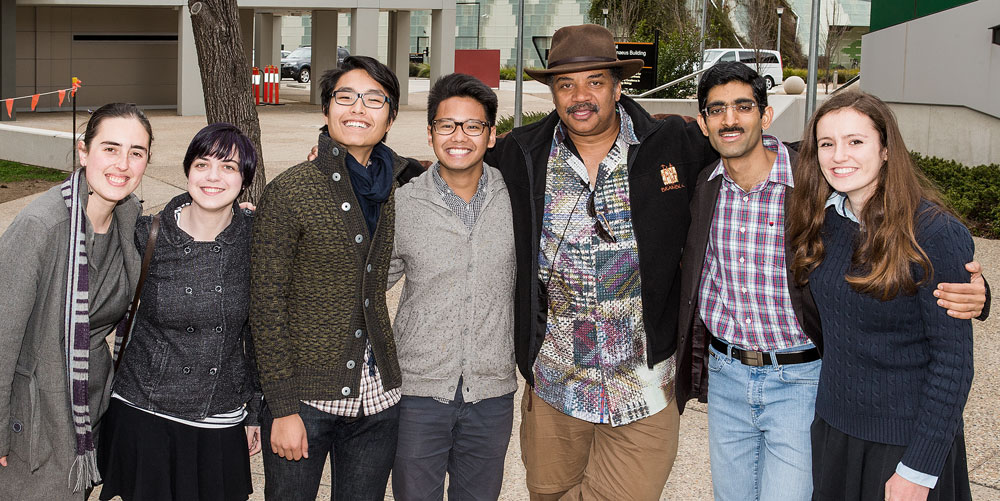Meeting a 'rock star' of science: Neil deGrasse Tyson
Science communication intern Zoë Tulip was one of six ANU students who welcomed astrophysicist Neil deGrasse Tyson to ANU for National Science Week.
It’s hard to imagine what might be happening within the collective minds of a group of students at the exact moment an astrophysicist and science communicator with global rock star status walks into a room. But when Neil deGrasse Tyson arrived at ANU he seemed determined to shake off any nerves anyone had about meeting him, and to do things a little differently.
Resplendent in a colourful shirt and an Akubra, he casually hopped out of a van with relatively little fanfare to a small waiting media contingent in the sciences precinct accompanied by friend—and future Vice Chancellor—Professor Brian Schmidt.
After a brief hello, the UNA sculpture quickly grabbed Neil’s attention. Understandably, a visiting astrophysicist might find it hard to ignore an artwork that draws inspiration from the cosmos itself.
Neil jokingly apologised for allowing himself to be introduced to the sculpture before being introduced to the students, but it wasn’t long before we were introducing ourselves.
His first collective comment on our backgrounds was “science communication is really a thing here, isn’t it?” as at least three of us had mentioned it. It didn’t escape me the irony that straight after our meeting was to be a recorded interview for KindaThinky, a live event series by two of my lecturers from the Australian National Centre for the Public Awareness of Science.
Neil soon found himself deep in conversation with astrobiology PhD candidate Adi Chopra, about Europa—one of the moons of Jupiter, and Lake Vostok—an Antarctic lake under ice which has not seen the surface for many millions of years. This quickly led to a discussion about Neil’s unfamiliarity with the oddly shaped local flora and fauna.
Following his descriptions of oddly low-hanging trees and creatures that could bounce, he mentioned that “a bird took my sausage the other day, on Green Island.” Much to the amusement of everyone present, a short time later a magpie flew down and landed between him and the sculpture, and proceeded to stare at him intently. It was as if the magpie had heard Neil and had decided to fly down, daring him to make any comments that might further defame bird-kind.
Eventually a question Imogen (another intern) and I had come up with was asked regarding his thoughts on his perspective on science and ways in which he thought it could make everyday life more interesting.
The answer generated, as we had hoped, several answers that spanned everything from the fundamental duty of educators, to our understanding of comets. Every time Brian tried to move things along however, Neil would suddenly re-approach the group of students with an enthusiastic “oh, and one other thing!” to add to the already gargantuan number of answers. He was like a pause/play button whose toggle would automatically time out after five seconds.
Inevitably though our time with him came to an end. However, before parting company, Adi presented Neil with a framed image of the Pale Blue Dot photo made famous by Carl Sagan. The group collaborated on a message to include with it, which in the end we all agreed accurately reflected our collective thoughts on his visit:
Dear Neil,
Thank you for sharing with us your awe inspiring vision for science and its communication. Your curiosity and enthusiasm is infectious - don't worry we won't tell that to the Australian Quarantine Service!
We hope you can visit us again to fire up our imagination and take us on a journey to explore the wonders of the cosmos. Until then, we’ll continue to keep an eye on Voyager from Canberra…
From all your mates down under at ANU.

